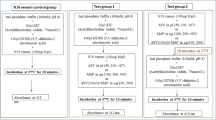Abstract
Alzheimer’s disease (AD) a key health problem chiefly in industrialized countries is characterize by memory loss in older persons. Treatments for AD include psychotropic mediators, disease-modifying managements, psychosocial interventions, and especially inhibition of cholinesterase (AChE) enzyme that will block the hydrolysis of a neurotransmitter acetylcholine (ACh). In the current study, it is reported for the first time that Anisomycine and Puromycin inhibit the activity of the AChE enzyme of krait venom. The results revealed that both Anisomycine (0.8–2.4 mM) and Puromycin (36.8–73.6 µM) exhibited AChE in a dose-dependent procedure. A kinetic study using the plot of Lineweaver Burk showed that both Anisomycine and Puromycin caused a competitive type of inhibition against AChE. The antibiotics (Anisomycin and Puromycin) compete with ACh for binding to the enzyme AChE active site. The Km of venom AChE for Anisomycin (0.8–1.6 mM) increased from 64 to 161% and the Vmax remains constant while for Puromycin (36.8–73.6 µM) the Km increased from 34 to 180% and did not affect the Vmax. The calculated IC50 for Anisomycine was found to be 1.4 mM while for Puromycine it was found to be 36.5 µM. In comparison, Puromycine has a more potent inhibitory effect than Anisomycine. It is concluded, that Anisomycin and Puromycin may possess the anti-AChE ability against Krait snake venom acetylcholinesterase.






Similar content being viewed by others
References
Ahmed M, Rocha JB, Correa M et al (2006) Inhibition of two different cholinesterases by tacrine. Chem Biol Interact 162:165–171. https://doi.org/10.1016/j.cbi.2006.06.002
Ahmed M, Khan SZ, Sher N, Rehman ZU, Mushtaq N, Khan RA (2021) Kinetic and toxicological effects of synthesized palladium(II) complex on snake venom (Bungarus sindanus) acetylcholinesterase. J Venom Anim Toxins Incl Trop Dis 27:e20200047. https://doi.org/10.1590/1678-9199-jvatitd-2020-0047
Bawaskar HS, Bawaskar PH (2002) Profile of snakebite envenoming in western Maharashtra, India. Trans R Soc Trop Med Hyg 96:79–84. https://doi.org/10.1016/s0035-9203(02)90250-6
Bradford MMA (1976) A rapid and sensitive method for the quantification of microgram quantities of protein utilizing the principle of protein-dye binding. Anal Biochem 72:248–254
Cousin X, Bon S, Duval N, Massoulie J, Bon C (1996) Cloning and expression of acetylcholinesterase from Bungarus fasciatus venom. A new type of cooh-terminal domain; involvement of a positively charged residue in the peripheral site. J Biol Chem 271:15099–15108. https://doi.org/10.1074/jbc.271.25.15099
Dunant Y, Babel-Guein E, Droz B (1980) Calcium metabolism and acetylcholine release at the nerve-electroplaque junction. J Physiol (paris) 76:471–478
Ellman GL, Courtney KD, Andres V Jr, Feather-Stone RM (1961) A new and rapid colorimetric determination of acetylcholinesterase activity. Biochem Pharmacol 7:88–95
Frobert Y, Creminon C, Cousin X et al (1997) Acetylcholinesterases from Elapidae snake venoms: biochemical, immunological and enzymatic characterization. Biochim Biophys Acta 1339:253–267
Grollman AP (1967) Inhibitors of protein biosynthesis. II. Mode of action of anisomycin. J Biol Chem 242:3226–3233
Kelly RB, Deutsch JW, Carlson SS, Wagner JA (1979) Biochemistry of neurotransmitter release. Annu Rev Neurosci 2:399–446. https://doi.org/10.1146/annurev.ne.02.030179.002151
Kesvatera T, Ustav M, Aaviksaar A (1979) Cobra venom acetylcholinesterase—II. Substrate specifity. Compar Biochem Physiol Part C 62:193–197. https://doi.org/10.1016/0306-4492(79)90009-1
Kumar V, Elliott WB (1973) The acetylcholinesterase of Bungarus fasciatus venom. Eur J Biochem 34:586–592
Lahiri DK, Rogers JT, Greig NH, Sambamurti K (2004) Rationale for the development of cholinesterase inhibitors as anti-Alzheimer agents. Curr Pharm Des 10:3111–3119
Lineweaver H, Burk D (1934) The determination of enzyme dissociation constants. J Am Chem Soc 56:658–666. https://doi.org/10.1021/ja01318a036
MacIntosh FC (1981) Basic neurochemistry. Little Brown and Co., Boston, pp 183–204
McNamee D (2001) Tackling venomous snake bites worldwide. Lancet 357:1680. https://doi.org/10.1016/s0140-6736(00)04868-6
O’Brien JT, Ballard CG (2001) Drugs for Alzheimer’s disease. BMJ 323:123–124. https://doi.org/10.1136/bmj.323.7305.123
Patrick GL (2001) An introduction to medicinal chemistery. Cholinergics, anticholinergics and anticholiesterase. Oxford University Press, Oxford
Rosenberry TL, Johnson JL, Cusack B, Thomas JL, Emani S, Venkatasubban KS (2005) Interactions between the peripheral site and the acylation site in acetylcholinesterase. Chem Biol Interact 157–158:181–189. https://doi.org/10.1016/j.cbi.2005.10.027
Sher N, Ahmed M, Mushtaq N, Khan RA (2020) Calligonum polygonoides reduced nanosilver: a new generation of nanoproduct for medical applications. Eur J Integr Med 33:101042
Sher N, Ahmed M, Mushtaq N, Khan RA (2022) Enhancing antioxidant, antidiabetic, and antialzheimer performance of Hippeastrum hybridum (L.) using silver nanoparticles. Appl Organomet Chem 36(7):e6724
Warrell DA (1999) The clinical management of snake bites in Southeast Asian region. Southeast Asian. J Trop Med Public Health 30:1–67
Wilson IB, Cabib E (1956) Acetylcholinesterase:enthalpies and entropies of activation. J Am Chem Soc 1:202–207
Acknowledgements
We wish to thank Higher Education Commission of Pakistan for financial support of the project (No. 20-5082/NRPU/R&D/HEC).
Author information
Authors and Affiliations
Contributions
MA conceived this research and designed experiments. AA, NM, NS, and RAK done the experiment, examined data, and wrote the paper.
Corresponding author
Ethics declarations
Conflict of interest
The authors have no conflict of interest.
Ethical Approval
The study was approved by the University of Science and Technology Bannu, Ethical Approval Committee Ref No: Biotech/Ethic/1000.
Additional information
Publisher's Note
Springer Nature remains neutral with regard to jurisdictional claims in published maps and institutional affiliations.
Rights and permissions
Springer Nature or its licensor (e.g. a society or other partner) holds exclusive rights to this article under a publishing agreement with the author(s) or other rightsholder(s); author self-archiving of the accepted manuscript version of this article is solely governed by the terms of such publishing agreement and applicable law.
About this article
Cite this article
Ahmed, M., Ahmad, A., Mushtaq, N. et al. Protective Role of Antibiotics (Anisomycin and Puromycin) Against Snake Venom Acetylcholinesterase (AChE). Int J Pept Res Ther 29, 13 (2023). https://doi.org/10.1007/s10989-022-10482-2
Accepted:
Published:
DOI: https://doi.org/10.1007/s10989-022-10482-2




